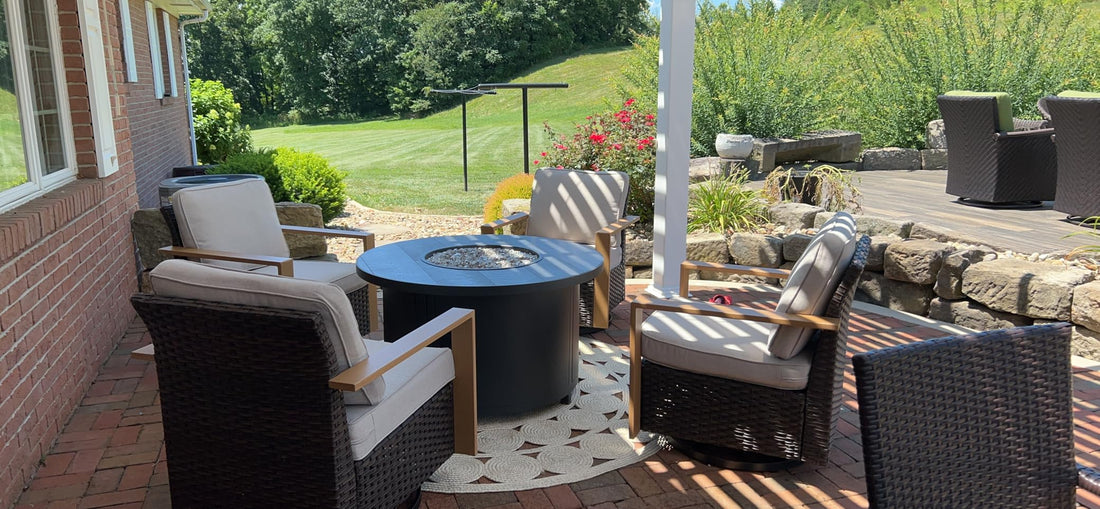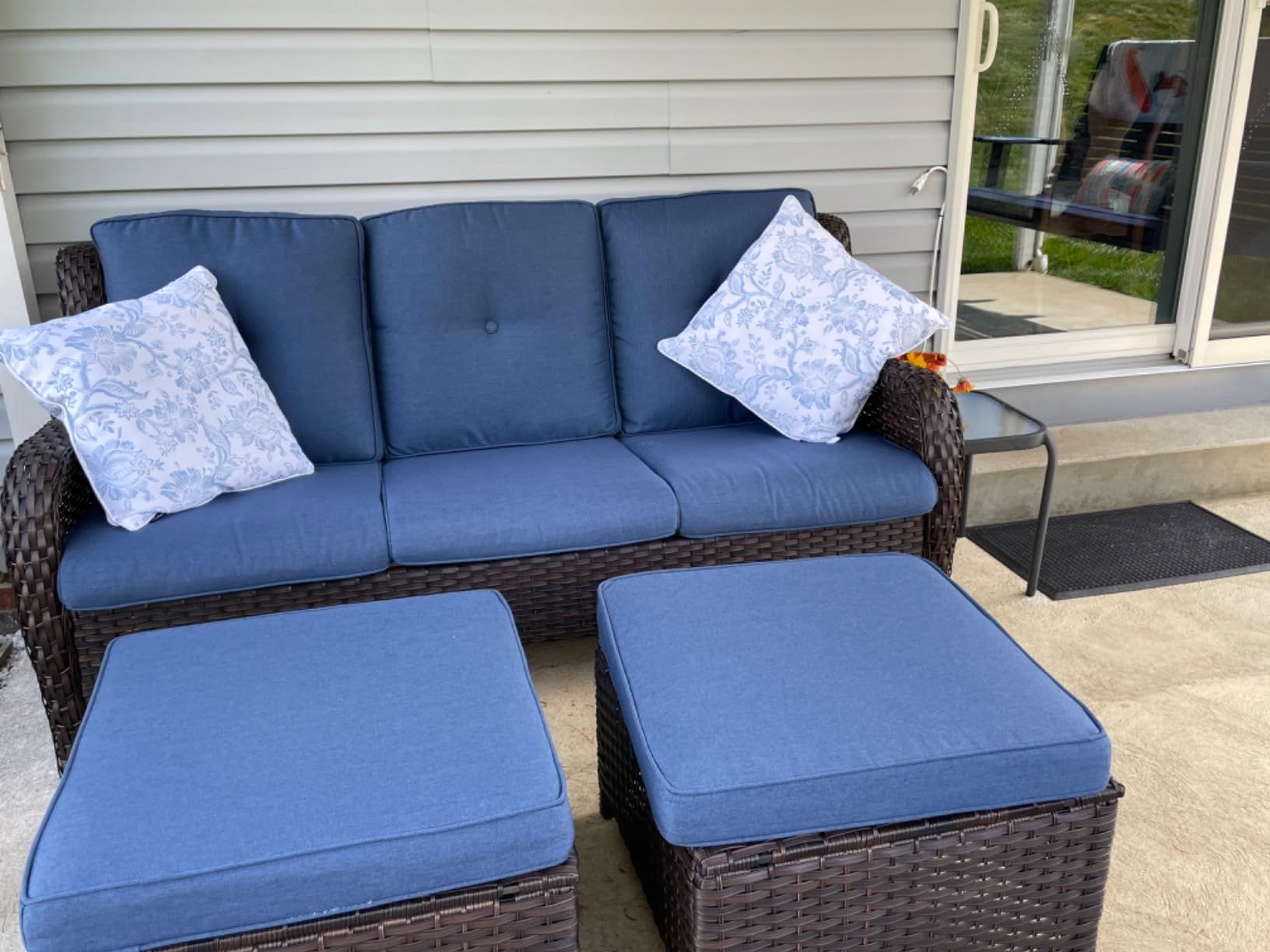
How to Maintain and Care for Your Patio Furniture Year-Round?
Share
When it comes to patio furniture, a little maintenance can go a long way in keeping your outdoor space looking fresh, welcoming, and well-kept all year round. Whether your set is wood, metal, or wicker, regular care and cleaning ensure that your investment lasts for many years while also staying comfortable and stylish.
In this blog post, we’ll explore easy-to-follow tips on how to maintain and care for patio furniture year-round. From preparing your furniture for harsh weather to cleaning tips for different materials, you’ll learn the best practices to protect your outdoor essentials from wear and tear. So, let's dive into the care and maintenance routines that will keep your patio looking its best through all four seasons.
Why Regular Patio Furniture Maintenance Matters
Outdoor furniture is exposed to the elements daily—sun, rain, wind, snow, and even dirt and debris. Without proper maintenance, your furniture can quickly become weathered, lose its appeal, or even degrade structurally. Routine care not only extends the lifespan of your patio set but also keeps it looking beautiful, adding to the charm of your outdoor living space.
Additionally, well-maintained patio furniture is more comfortable to use. Cushions, fabrics, and wooden surfaces remain soft and inviting instead of becoming stiff, brittle, or moldy. The effort you put into maintenance pays off with outdoor spaces that are as functional as they are attractive.
1. General Care Tips for All Types of Patio Furniture
Regardless of the material, there are several universal care tips that apply to most types of patio furniture:
Regular Cleaning: Cleaning your furniture frequently prevents dirt, pollen, and other environmental contaminants from accumulating. Use mild soap and water for most surfaces, and always wipe the furniture dry to prevent water damage.
Protection from Weather: Use protective covers when your furniture is not in use, especially during rainy seasons or harsh winters. This simple step prevents fading, rust, and warping from moisture and UV rays.
Proper Storage: If possible, store your patio furniture indoors during extreme weather, particularly in the winter. If you don’t have the space, invest in heavy-duty outdoor covers that provide excellent protection.
Avoid Abrasive Cleaners: Never use harsh chemicals or abrasive cleaning pads on your furniture, as they can scratch surfaces, degrade finishes, or cause permanent stains.
Reapply Protective Coatings: For materials like wood or metal, consider reapplying protective sealants or waxes to safeguard against rust and decay.
2. Cleaning and Maintenance Based on Material
Now let’s break down specific care tips based on the type of patio furniture material you own:
Wooden Patio Furniture
Wooden patio furniture, such as teak, cedar, and eucalyptus, is durable and beautiful but requires regular upkeep to prevent weathering.
Regular Dusting: Dust wooden surfaces frequently to keep dirt and grime from embedding in the wood grain.
Wash Gently: Clean with mild soap and water, using a soft-bristle brush to get into crevices without damaging the wood.
Oil or Seal: For hardwoods like teak, it’s important to oil the surface every few months to retain the wood’s rich color and prevent cracking. For softwoods, apply a sealant to protect against moisture.
Cover or Store: Wood can expand, crack, or warp due to weather exposure. Cover your wooden furniture or store it in a dry place during winter or heavy rains to prevent damage.
Metal Patio Furniture
Metal patio furniture, whether aluminum, wrought iron, or steel, is extremely durable but can be prone to rust if not cared for properly.
Regular Wipe-Downs: Clean metal surfaces with mild soap and water. Avoid using steel wool or rough sponges, as these can scratch the finish and expose the metal to rust.
Check for Rust: For wrought iron or steel, inspect your furniture regularly for rust spots. If you find any, use a rust-removing solution and touch up the area with rust-resistant paint.
Reapply Protective Coatings: Every year, apply a protective sealant or clear coat to prevent rust from forming in the first place.
Avoid Scratches: Metal furniture can chip, so be mindful of how you move or handle it to prevent scratches that could expose the metal to corrosion.
Wicker or Rattan Patio Furniture
Wicker and rattan furniture add a charming, natural look to outdoor spaces but require more attention to detail in terms of cleaning and storage.
Vacuum and Dust Regularly: Wicker and rattan can trap dust and dirt in their intricate weaves. Use a vacuum cleaner with a brush attachment or a soft cloth to remove debris.
Wash Sparingly: When cleaning, use a mild soap solution and gently scrub the surfaces with a soft brush. Don’t soak wicker furniture, as excessive moisture can weaken the fibers.
Weather Protection: Wicker can deteriorate under prolonged exposure to sun and rain, so it’s vital to store or cover wicker furniture when not in use.
Resin Wicker: For synthetic wicker furniture, follow similar cleaning practices, but know that resin wicker is more resistant to weather damage and easier to maintain.
Plastic or Resin Patio Furniture
Plastic and resin furniture are the easiest to maintain, but they can still suffer from fading or cracking due to UV exposure.
Frequent Cleaning: Wash plastic furniture regularly with soap and water to prevent stains. Plastic tends to attract dirt easily, so wiping it down often will help maintain its appearance.
Avoid Harsh Chemicals: Do not use abrasive cleaners or bleach, as they can cause the plastic to degrade or discolor.
Protection from UV Rays: Plastic furniture can fade in the sun, so consider placing it in shaded areas or applying a UV-resistant spray.
Prevent Cracking: If your furniture is exposed to freezing temperatures, plastic can crack. Store it indoors during winter, or use heavy-duty covers to protect it from the cold.
3. Caring for Outdoor Cushions and Fabrics
Your outdoor cushions and fabrics also require special attention to maintain their softness, color, and longevity:
Frequent Cleaning: Brush off dirt and debris regularly. Wash cushion covers following the manufacturer’s instructions, using mild detergents and cold water.
Mold Prevention: If your cushions get wet, make sure they dry thoroughly to avoid mold and mildew. Use waterproof cushion covers for extra protection during rainy seasons.
Store Indoors: If possible, bring cushions inside during inclement weather. When storing for the winter, place them in a dry, well-ventilated space to prevent mildew.
UV Protection: Sun exposure can cause fabric colors to fade. Use furniture covers with UV protection or store cushions in a shaded area to prevent fading.
4. Preparing for Different Seasons
Your patio furniture’s maintenance schedule will vary depending on the season. Here's how to care for it during different times of the year:
Spring
Spring is the perfect time for a deep clean. Remove any covers, wash the furniture, and inspect it for any signs of wear or damage that may have occurred over the winter. It’s also a great time to reapply protective coatings or oil to wood furniture.
Summer
During summer, protect your furniture from prolonged exposure to the sun by placing it under an umbrella or in a shaded area. Regularly clean your furniture to keep dirt, pollen, and bird droppings at bay.
Fall
As the weather cools down, give your furniture a final cleaning before putting it into storage or covering it up for the winter. Fall is also a good time to make any necessary repairs, such as touching up paint on metal furniture or sanding and re-staining wood.
Winter
If you live in an area with harsh winters, storing your patio furniture indoors is ideal. For those without storage space, investing in high-quality, weather-resistant covers will protect your furniture from snow, ice, and freezing temperatures.
5. Storing Your Patio Furniture Properly
If you’re looking for the best way to extend the life of your patio furniture, proper storage is key. Whether you’re storing your furniture for the winter or simply making room for other outdoor activities, here’s how to do it right.
Clean Before Storing: Always clean your furniture thoroughly before storing it, removing dirt, grime, and moisture that can cause damage over time. Dry everything completely to prevent mold and mildew growth.
Cover and Protect: For long-term storage, invest in high-quality furniture covers. Store metal, wood, and wicker furniture in a dry, cool place to avoid exposure to moisture or extreme temperatures. If possible, place furniture off the ground using pallets to prevent moisture from seeping in from the floor.
Store Cushions Indoors: Cushions and pillows should always be stored indoors, especially in damp or cold climates. Consider investing in storage bins or bags to keep them safe and organized.
Conclusion
Maintaining your patio furniture year-round doesn’t have to be a daunting task. By incorporating regular cleaning routines, using protective covers, and storing your pieces properly, you can extend the life of your outdoor furniture and keep it looking great for years to come.
A little preventive care—such as reapplying protective coatings or oiling wood furniture—can save you time and money in the long run, ensuring that your outdoor space remains inviting and ready for use in every season.
Related blog: how to repair outdoor patio furniture

